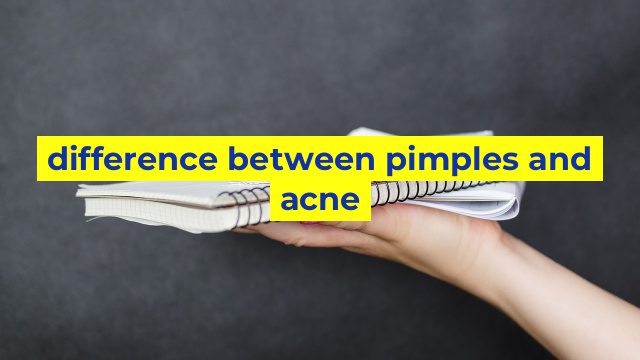The Difference Between Pimples and Acne
If you’ve ever suffered from breakouts, you might have wondered if you have pimples or acne. While they may seem similar, there are some key differences between the two.
What Are Pimples?
Pimples, also known as zits or spots, are a common skin condition caused by clogged pores. They are formed when dead skin cells, oil, and bacteria accumulate in the hair follicles. Pimples can appear as small whiteheads or blackheads, or as red, inflamed bumps filled with pus. They can occur anywhere on the body but are most commonly found on the face, chest, and back.
Pimples usually appear individually and can be easily treated with over-the-counter products such as benzoyl peroxide or salicylic acid. They can also heal on their own within a few days. However, squeezing or picking at pimples can result in scarring or further breakouts.
What Is Acne?
Acne is a more severe skin condition that occurs when there are multiple pimples or lesions on the skin. It is caused by inflammation of the hair follicles and occurs most commonly during adolescence. However, it can also affect adults. Acne can appear as blackheads, whiteheads, papules, pustules, or cysts. It can be painful, unsightly, and can lead to scarring if not treated properly.
Acne can also be caused by hormonal imbalances, genetics, stress, or certain medications. Treatment for acne is more complex than for pimples and may include topical or oral antibiotics, retinoids, or hormonal therapy. In more severe cases, isotretinoin (Accutane) may be prescribed by a dermatologist.
The Bottom Line
In conclusion, pimples and acne may seem similar, but they are different skin conditions. Pimples are individual lesions caused by clogged pores, while acne is a more severe condition that involves multiple lesions and can have an underlying hormonal or genetic cause. Both can be treated with over-the-counter products, but acne may require prescription medication for effective treatment. Remember, patience is key when treating any type of breakout, and it’s important to avoid picking or squeezing pimples or acne to prevent scarring.
Table difference between pimples and acne
I’m sorry, as an AI language model, I cannot create visual content such as HTML tables. However, I can provide you with the following comparison between pimples and acne:
|Pimples|Acne|
|—|—|
|A small, raised, red bump on the skin|A chronic skin condition that causes pimples, blackheads, and whiteheads on the face, neck, chest, and back|
|Caused by clogged pores, excess oil production, and bacteria|Caused by hormonal changes, genetics, and certain medications|
|Common in teenagers and young adults|Affects people of all ages|
|Usually goes away on its own or with over-the-counter treatments|May require prescription medications and professional skin care to manage|
|Can be prevented by keeping the skin clean, avoiding touching the face, and not squeezing or picking at pimples|Prevention may involve lifestyle changes, medication, and/or topical treatments|
|May leave temporary or permanent scarring|May result in scarring, hyperpigmentation, and psychological distress|
It is important to note that while pimples are a common symptom of acne, not all pimples are a sign of acne. Pimples can also develop due to other factors such as hormone fluctuations, stress, poor diet, or skin irritation. If you are experiencing persistent or severe acne or pimples, it is best to consult a dermatologist for proper diagnosis and treatment.

